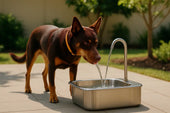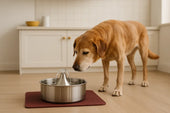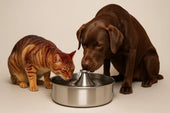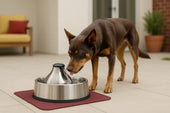Key Takeaways
- Opt for one that suits your small dog’s height and snout length for easy, strain-free feeding.
- Choose shallow, wide bowls to reduce the risk of digestive problems such as bloating occurring, particularly in flat-faced or short-nosed breeds.
- Opt for durable, easy to clean materials (stainless steel or good quality ceramic) for better hygiene.
- Choose non-slip and weighted bowls to reduce mess and maintain the feeding area clean, even for voracious eaters.
- Choose the bowl width and depth as your pup matures. If their appetite varies, ensure they have a snug fit at every stage of life!
- Ask your Aussie vet for specific advice based on your dog’s breed, age and special dietary or health concerns.
Little dogs do best with bowls of 250–350 ml. Opt for one with a shallow rim and a base width of about 10-15 cm. Shallow bowls allow short snouts and little jaws access to food or water.
In Australia, stainless steel and ceramic are popular due to hygiene and wipe-down cleaning. Non-slip bases prevent sliding on tiled or wooden floors, which comes in useful for many Aussie homes.
Pick the right bowl size to prevent spills. It also relieves strain on your neck and joints, as many local vets point out. Some owners choose raised bowls for senior small dogs with arthritis.
Below the guide details how to choose the correct bowl according to breed, speed of eating and home layout.
Why Bowl Size Matters, Mate
Bowl size is more important than most people realise in your small dog’s daily life. A perfectly-fitting bowl does more than keep one’s food. It influences your dog’s eating style, keeps them cosy while they munch and prevents digestive incidents.
In Australian houses, dogs are really part of the family. So, getting these details accurately correct is important for both the pet and the owner.
Comfort at Chow Time
The bowl’s size (and height) should be suited to your dog’s frame. Small breeds such as Mini Dachshunds or Chihuahuas need a shallow bowl that’s close to the floor. So they can eat with their heads and necks in a natural position.
Dogs eat more quietly if they’re not straining,” notes Sydney-based dog trainer Dr. Louise Ginman. The bowl diameter also makes a difference. Flat-faced breeds such as Pugs will find a wider bowl easier to eat from.
On the other hand, longer-nosed dogs cope better with a deeper dish. This prevents food spilling onto the floor and makes for a stress-free meal.
Preventing Digestive Woes
It impacts digestion, too. Small, shallow bowls are ideal. Small dogs tend to gulp air when their bowl is too deep or wide. It’s the sort of thing that can result in bloat.
Lagging edges reduce pace and allow a fair go for the gut. For dogs that eat too quickly, use a bowl with a smaller surface area or a slow-feed design.
The right bowl depth aids digestion and less post-eating bloating,” says nutritionist Dr. Kate Mornement.
Keeping Mealtime Tidy
A correctly-sized dog food bowl minimizes the mess, especially when it features higher sides to stop kibble and water from scattering. Meanwhile, a non-slip base ensures the elevated dog bowl stays anchored during an enthusiastic feed, enhancing the overall feeding experience for your canine companion.
Choosing a bowl that accommodates your dog's meal sizes simplifies cleanup and reduces the chance of germs, keeping everything clean and hygienic for pet owners.
Finding the Paw-fect Bowl Size

Selecting the best bowl size for tiny dogs in Australia is more than choosing what matches nicely in your kitchen. The right fit will allow your dog to eat comfortably, avoid spillage and promote good health. Measuring your dog’s height and snout length is a clever first step.
For most small breeds, bowls measuring between 5 x 1.5 inches (5 oz) up to 6 x 2 inches (17 oz) are suitable. Select the size that's right for your pet!
1. Consider Your Dog's Breed
Breed needs matter. Chihuahuas, Toy Poodles and Yorkshire Terriers naturally suit smaller, shallower bowls. Pugs and French Bulldogs have wider faces. They might require wider bowls since flat-faced breeds fare better with bowls that won’t sit against their noses.
The RSPCA and Australian Veterinary Association both acknowledge that pairing bowl size with breed decreases stress at meal times.
Common small breeds and bowl sizes:
- Chihuahua, Yorkie: 5 x 1.5 inches (5 oz)
- Pug, Frenchie: 6 x 2 inches (17 oz)
- Mini Schnauzer: 6 x 2 inches (17 oz)
2. Factor in Their Snout Shape
Snout length alters the ideal dog bowl required. Wide, shallow dog food bowls assist flat-faced dogs, such as Pugs, in breathing and eating easily, while longer-nosed types, like Dachshunds, may favor deeper bowls.
3. How Deep Should It Be?
Gulpers will find shallow dog food bowls or slow-feeder bowls helpful. These choices can slow down their eating habits and aid digestion. Outgoing dogs who paw at or roll around with food may benefit from a deeper elevated dog bowl to hold kibble.
4. Width: Room to Munch
A bowl should be wide enough for your dog’s mouth – narrower bowls can make for awkward eating. Wide bowls are ideal for breeds with flat faces.
For instance, most small Aussie breeds are happy with a 13cm wide bowl.
5. Adjust for Age & Appetite
Puppies grow fast, so their dog bowl size will need replacing. Monitor age or health-related appetite changes. A checklist helps: review dog breeds, age, appetite, snout shape, and eating pace.
Bowl Materials: What's Best?
Selecting the correct bowl for a small dog is not just about size. The material is important for hygiene, ease of cleaning, and how the bowl works in typical Aussie homes. Each has its pros and cons. Some owners want a discreet bowl, while others prioritise hygiene or eco-friendliness.
Here’s what stands out about the most popular options.
Stainless Steel: Tough & Clean
Stainless steel bowls are essential in many Australian kitchens. They’re durable, won’t rust and don’t absorb smells. They’re easy to clean and dishwasher-safe.
The heavy base prevents the bowl from sliding around or tipping as your pup eats. Stainless steel is least likely to breed bacteria,” says Dr Karen Davies, Sydney vet. They suit any house, even if they can be a little bland.
Ceramic: Stylish but Check Glaze
Ceramic bowls add a little panache with vibrant patterns and silky glazes. They help keep things cool and dry stall-side, which is useful during hot Aussie summers.
Double-check that the glaze is non-toxic and lead-free. They’re heavy, so rarely tip, but can chip or crack if dropped.
Plastic: Cheap but Scratches Easily
Plastic bowls are affordable and lightweight. They are travel-friendly but scratch rapidly. Scratches harbour bacteria, so opt for BPA-free plastic and replace bowls regularly.
They aren’t as durable as other options and require regular inspection for signs of wear.
Silicone & Bamboo: Newer Options
Silicone bowls fold flat for travelling, ideal for walks or camping. What makes bamboo bowls so special is their sustainable, unique design.
Both are lightweight, but may not stand up as well as steel or ceramic.
|
Material |
Pros |
Cons |
|---|---|---|
|
Stainless Steel |
Durable, hygienic, easy clean |
Plain look, can dent |
|
Ceramic |
Stylish, keeps cool, heavy |
Chips/cracks, check glaze |
|
Plastic |
Cheap, light, colourful |
Scratches, less durable |
|
Silicone |
Foldable, light, portable |
Wears out, less sturdy |
|
Bamboo |
Eco, unique look |
Not as strong, can splinter |
|
Glass |
Clear, non-porous |
Breaks easily, heavy |
|
Acrylic |
Blends in visually |
Can scratch, not as tough |
Elevated Bowls: Good Idea?
Elevated bowls are frequently sold as a clever upgrade for your dog’s feeding! They’re not the most practical option, especially for small breeds. These elevated configurations are great for big breeds such as Golden Retrievers or Labs, who require a bowl 15-20cm above the floor.
It’s another story for little buddies like Chihuahuas or Maltese. Most small dogs do well with bowls only 2–6 cm high, if any height at all. It’s all about your dog’s health, posture and feeding habits.
Potential Perks for Some Pups
Some small breeds, such as the Dachshund and Miniature Schnauzer, are already long-bodied or prone to gastroenteric problems. To assist food gliding down more easily into the stomach, elevated bowls can be useful for them.
Senior dogs who have stiff joints or arthritis will appreciate a bowl that is at a comfortable height. Then they don’t have to bend over so much. Proper feeding height is important, says Sydney vet Dr Emily Jones. Her tip is: “A good rule is to set the rim about 3cm below your dog’s shoulder.
Raised bowls do minimise mess, particularly if they feature non-slip bases or high sides.
When to Skip the Lift
Not every pooch finds it helpful. Dogs susceptible to bloat or other gastrointestinal issues should steer clear of elevated bowls. The lift only exacerbates their illness.
If your dog eats too fast or is too excitable at mealtimes, think about an elevated bowl. It might fall over or slip if they fidget! Most owners find their dogs want their food on the floor. Regular bowls make cleaning a breeze!
Chat with Your Aussie Vet
It’s worth having a chat with your vet before swapping things up. They’ll figure out whether your pup requires a raised bowl according to its breed, age or health.
They can help you pick the correct size! Vet checks detect if your dog’s eating habits change, making sure their feeding set-up is on point.
Smart Bowl Design Features
Smart design can be a game-changer when it comes to selecting the ideal dog bowl for small dog breeds in Australia. Must-have elements like non-slip bottoms and easy-clean surfaces enhance your dog’s feeding experience, catering to varying eating styles and ensuring your canine companion enjoys every meal.
Non-Slip Bottoms are Crucial
Rubberised-bottomed bowls don’t slide around, even on slippery kitchen tiles or polished floorboards. This holds the bowl in position for dogs who chow down with enthusiasm.
For houses housing active hounds or slick flooring, non-slip features relieve mealtimes of the mess and stress. A stable bowl reduces mess and helps dogs focus on eating,” says Sydney-based vet, Dr Kate Morningside.
This design ensures that food stays where it should be and saves owners from daily clean-ups.
Easy-Clean Bowls Save Time
Dishwasher-safe bowls are a godsend for busy pet parents. Stainless steel or premium plastic is stain and odour resistant, keeping them fresh for longer.
Seek out bowls with round edges and no tight corners – food can’t hide, so the bowl remains cleaner. A simple checklist: rinse after each meal, deep clean weekly, and check for cracks or worn surfaces.
Slow Feeder Bowls for Gobblers
Patterns and textures designed to slow down eating help digestion and prevent bloat. Certain smart bowls can reduce eating speed by as much as 15 times.
They are particularly good for greedy or nervous dogs. Flat-faced breeds, meanwhile, prefer wide, tilted bowls which make it easier for them to eat and drink.
Weight: Heavy Enough to Stay Put
A bowl with a bit of weight – such as ceramic or weighted plastic – will stay still during mealtimes. For excitable pooches, this equates to less tipping and fewer spills.
Balance weight against washability, so owners aren’t left lugging heavy bowls to the sink.
Must-have bowl features:
- Non-slip base
- Dishwasher safe
- Slow feeder option
- Durable, stain-resistant material
- Suitable width and depth for your dog’s face shape
- Optional: digital scale, adjustable height, and dual-bowl design
Creating a Cracker Feeding Spot

A properly established feeding area can have a considerable impact for small dogs. It aids dogs in associating a place with food, rendering mealtimes all the easier to handle. In Australia, homes vary from flats in the cities to bigger houses. Choosing the right dog bowl really comes down to what suits your lifestyle and your dog’s needs!
Select a spot that’s away from the main walkways. It should be orientated away from noisy areas, such as the kitchen entrance or back door. Away from the hustle and bustle, quiet corners in the laundry or a low-traffic spot in the kitchen tend to be ideal. This allows your dog to concentrate on eating, with less anxiety and fewer interruptions.
If you have a puppy, try making the feeding spot in or near a crate. This can help to make the crate a pleasant place for your canine companion!
Key things to check when picking the spot include ensuring that the elevated dog bowls are at the right height to alleviate neck strain, particularly for older or flat-faced breeds. Use a bowl with a wide base or lip to cut down spills. For mess control, a non-slip, machine-washable mat under the bowl cuts down on cleaning and protects the floor.
- Is it secure and unobstructed (lace, vacuum-techniques or vegetation)?
- Can your dog reach food and water bowls easily?
- Does the floor handle spills well, or do you require a mat?
- Is it easy to clean each day?
A bowl at the right height alleviates neck strain, particularly for older or flat-faced breeds. Use a bowl with a wide base or lip to cut down spills. For mess control, a non-slip, machine-washable mat under the bowl cuts down on cleaning and protects the floor.
Overall, creating a designated feeding area with the right dog bowl materials can enhance your dog's eating habits and make mealtime a more enjoyable experience.
Conclusion
A bowl to suit your small dog’s requirements simply makes life easier for you both. Opt for a bowl approximately 10–15cm wide and 3–5cm deep. That size prevents mess and encourages your dog to eat calmly. Opt for durable materials such as stainless steel or thick ceramic – easy to wipe out, and lasts for ages. Raised bowls are great for some, but not all dogs, so observe how your buddy eats. Clever designs and non-slip bases protect your floors from spills. A cosy place in a quiet corner will make your dog feel secure at meal times. Provide your little buddy the appropriate bowl and witness the change! Have a tip or question? Drop it in the comments.
Frequently Asked Questions
What size bowl suits small dogs best?
A 10-15cm dog bowl size is spot on for most small dog breeds in Australia. It needs to have a capacity of 250–350 ml, which discourages overeating and is accessible for small puppies.
Do small dogs need shallow bowls?
Indeed, shallow dog food bowls are ideal for small dog breeds. They offer dogs easy access to food and water while helping limit neck strain, especially in short-nosed breeds.
Which bowl material is safest for small dogs?
Stainless steel is the most durable and safest option for dog food bowls. It’s simple to clean, doesn’t retain bacteria, and is less prone to causing allergies.
Are elevated bowls a good idea for small dogs?
Elevated dog bowls may assist certain small dog breeds, particularly older or arthritic ones, while a standard dog bowl on the ground is fine for most fit small puppies.
How often should I clean my small dog’s bowl?
Wash your dog’s food bowl and water bowl daily in hot, soapy water to avoid bacteria growth and ensure your canine companion stays healthy.
Can using the wrong bowl cause problems for small dogs?
Yep! Having an elevated dog bowl that’s overly deep can create a pain in the neck (literally, and figuratively) for your small breed. A porous dog bowl can even result in health problems!
What features should I look for in a small dog bowl?
Search for non-slip bases, dishwasher-safe materials, and the right dog bowl size and depth. These characteristics ensure mealtimes are mess-free and relaxed for you and your canine companion.

























